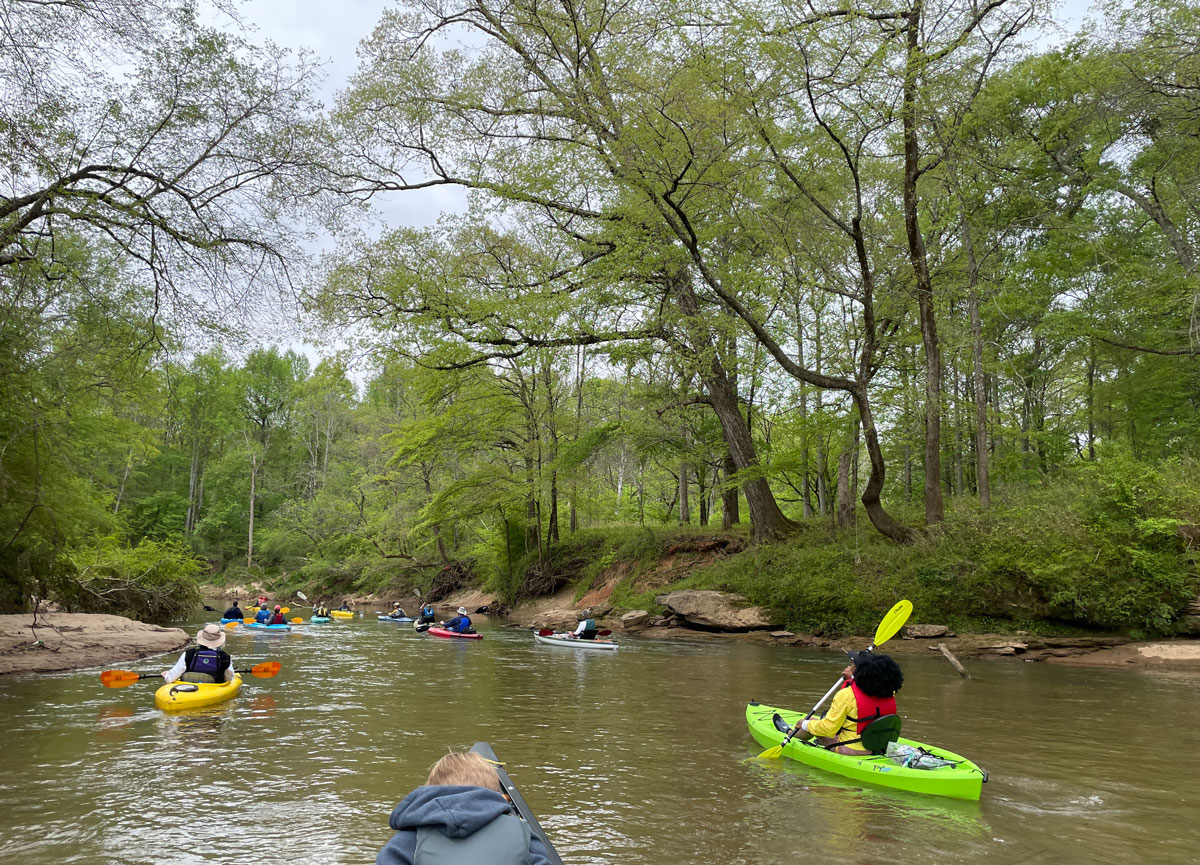
Photograph courtesy of South River Watershed Alliance
Through a slim gap in the chain-link fence, Jacqueline Echols leads me down a short, steep embankment and across a wide sand beach toward the banks of the South River. Deer tracks and footprints pepper the sand at our feet; ahead of us, water rushes dramatically beneath the Snapfinger Road bridge and tumbles over shoals, where Echols tells me she’s seen river otters play. With its sprawling stretch of beach and sounds of rushing water, the Panola Shoals trailhead feels like an urban enclave of natural beauty—idyllic, almost, if not for the signage on the fence warning visitors of the contaminated water.
For decades, sewage runoff from Atlanta and DeKalb County has tainted the South River, which starts in East Point and flows 60 miles southeast to Jackson Lake through a number of mostly Black and brown communities. Echols, the board president of the South River Watershed Alliance, has dedicated more than 20 years to restoring the waterway, tirelessly imploring local municipalities to improve conditions on the river. Progress can feel like a trickle. In 2011, a federal judge ordered DeKalb County to eliminate sewage spills within a 10-year time frame, but that deadline came and went, while the spills continue. For the SRWA, which conducts its own bimonthly water-quality testing, finding and eliminating sources of contamination—an overflowing manhole here, an apartment complex sewer break there—is an ongoing game of environmental whack-a-mole. Meanwhile, as the Atlanta Police Foundation moves forward with its proposed police training facility, just miles upstream from where we now stand, advocates worry the development will only compound the river’s struggles with pollution and stormwater runoff.
Those frustrations, however, only seem to galvanize Echols, who sees the river’s long legacy of neglect and degradation in historically Black communities as an issue of social and racial justice, too. Today, she’s describing to me the vision for the Panola Shoals site, which she calls “the gateway to the South River”: retaining walls to stop erosion, a staircase and ADA ramp from the parking lot down to the beach, maybe even an outdoors outfitter one day. But most importantly: people.
“In Georgia right now, the only way to improve water quality in this river is to get people on it,” Echols says. The state’s “designated use” system applies different water-quality standards based on how people use a waterway. Currently classified as “fishing,” the South River is saddled with the lowest standards and the least protection. To upgrade the river’s designated use to “recreation,” with its stricter standards for cleanliness, the SRWA has to prove that people use it that way. And that involves asking the community to take a leap of faith: to take a chance on the river, so that it might have a chance at being restored.
These days, a key part of the SRWA’s work takes place not just in courthouses but in kayaks and canoes. In 2011, the group started offering guided paddle trips down the river, giving Atlantans a more intimate experience of the river than they could get from cruising its overpasses. The organization also began working with municipalities along the river to develop the South River Water Trail, a connected system of safe and legal access points with parking and ramps, every few miles.
In the years since, Echols and the SRWA have introduced countless Atlantans to the South River. Many of them live in the surrounding community and have never laid eyes on the river before, or perhaps only glimpsed it from the bridges above. Many have never paddled in a kayak or canoe. Some don’t swim. Most, Echols tells me, are awestruck to encounter this kind of beauty in their own backyards. “The folks that go down the river are just amazed at how beautiful it is,” says Echols, who lights up when she talks about the prospect of a sustainable ecotourism destination in a predominantly Black community. “I’ve seen how folks in the community have turned out. And they want what everybody else wants. People, generally, are drawn to nature.”
For a river continually beset by problems, the South River is healing. The week before we meet, Echols tells me, one perennially plagued section of the river reported its best water-quality test results she’s seen in over two years. Wildlife is abundant here; despite (and, in part, because of) decades of neglect, the river’s banks have remained virtually untouched by development, and the corridor is home to deer, beavers, otters, snapping turtles, herons, ducks, and, more recently, a resurgence of fish. “The river is very much alive,” Echols says. “That just shows you how resilient nature is: You give it a little bit of help, it’ll do the rest. And that’s what’s happening here.”
Four ways to experience the South River
1. Go birding (and spot other wildlife, too). On a recent paddling trip, Echols says, an avid birdwatcher counted 43 species seen or heard in just one morning.
2. Walk, run, or bike along the PATH Foundation’s Southtowne Trail to get a glimpse of the river from Swann Nature Preserve, or visit Intrenchment Creek Park and follow the South River Trail east toward Arabia Mountain.
3. Take an easy paddling trip. SRWA’s 6.5-mile guided canoe and kayak trips are designed to accommodate all ages and skill levels. Routes take paddlers past Panola Mountain State Park, Arabia Mountain National Heritage Site, and the Monastery of the Holy Spirit. Sign up for the SRWA’s newsletter to learn about planned outings.
4. For more experienced kayakers, the river offers plenty of adrenaline: Echols says that shoals in Rockdale County make the run from Everett Park to Lorraine Park an exciting challenge.
This article appears in our April 2023 issue.













